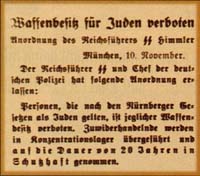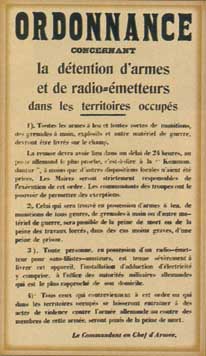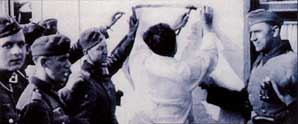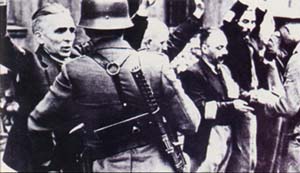The following article, written inn 2001, is a well documented piece on German confiscation of guns before and during WWII as well as similar plans that were proposed during the same time. Should anyone not know what occurred then, this is a great primer.
Conservative Tom
By Stephen P. Halbrook, Ph.D., J.D.
New research into Adolf Hitler's use of firearms registration lists to confiscate guns and the execution of their owners teaches a forceful lesson -- one that reveals why the American people and Congress have rejected registering honest firearm owners.

t would be instructive at this time to recall why the American citizenry and Congress have historically opposed the registration of firearms. The reason is plain. Registration makes it easy for a tyrannical government to confiscate firearms and to make prey of its subjects. Denying this historical fact is no more justified than denying that the Holocaust occurred or that the Nazis murdered millions of unarmed people.
I am writing a book on Nazi policies and practices which sought to repress civilian gun ownership and to eradicate gun owners in Germany and in occupied Europe. The following sampling of my findings should give pause to the suggestion that draconian punishment of citizens for keeping firearms necessarily is a social good. At the time of the Nazi attack on Jews known as Night of the Broken Glass, Heinrich Himmler, head of the Nazi SS and Police, ordered Jews disarmed (click for closeup). People's Observor (Völkische Beobachter), Nov. 10, 1938. At the time of the Nazi attack on Jews known as Night of the Broken Glass, Heinrich Himmler, head of the Nazi SS and Police, ordered Jews disarmed (click for closeup). People's Observor (Völkische Beobachter), Nov. 10, 1938.
|
The Night of the Broken Glass (Kristallnacht)--the infamous Nazi rampage against Germany's Jews--took place in November 1938. It was preceded by the confiscation of firearms from the Jewish victims. On Nov. 8, the New York Times reported from Berlin, "Berlin Police Head Announces 'Disarming' of Jews," explaining:
The Berlin Police President, Count Wolf Heinrich von Helldorf, announced that as a result of a police activity in the last few weeks the entire Jewish population of Berlin had been "disarmed" with the confiscation of 2,569 hand weapons, 1,702 firearms and 20,000 rounds of ammunition. Any Jews still found in possession of weapons without valid licenses are threatened with the severest punishment.1On the evening of Nov. 9, Adolf Hitler, Propaganda Minister Joseph Goebbels, and other Nazi chiefs planned the attack. Orders went out to Nazi security forces: "All Jewish stores are to be destroyed immediately . . . . Jewish synagogues are to be set on fire . . . . The Führer wishes that the police does not intervene. . . . All Jews are to be disarmed. In the event of resistance they are to be shot immediately."2
All hell broke loose on Nov. 10: "Nazis Smash, Loot and Burn Jewish Shops and Temples." "One of the first legal measures issued was an order by Heinrich Himmler, commander of all German police, forbidding Jews to possess any weapons whatever and imposing a penalty of twenty years confinement in a concentration camp upon every Jew found in possession of a weapon hereafter."3Thousands of Jews were taken away.
Himmler, head of the Nazi terror police, would become an architect of the Holocaust, which consumed six million Jews. It was self evident that the Jews must be disarmed before the extermination could begin.
Finding out which Jews had firearms was not too difficult. The liberal Weimar Republic passed a Firearm Law in 1928 requiring extensive police records on gun owners. Hitler signed a further gun control law in early 1938.
Other European countries also had laws requiring police records to be kept on persons who possessed firearms. When the Nazis took over Czechoslovakia and Poland in 1939, it was a simple matter to identify gun owners. Many of them disappeared in the middle of the night along with political opponents.
 The Holland Poster banning guns (click for closeup). Citizens had 24 hours to surrender all firearms to the Nazis or face the death penalty. Printed in German on the left and Flemish on the right. For translation, see below. From Die Deutsche Wochenschau, May 15, 1940. The Holland Poster banning guns (click for closeup). Citizens had 24 hours to surrender all firearms to the Nazis or face the death penalty. Printed in German on the left and Flemish on the right. For translation, see below. From Die Deutsche Wochenschau, May 15, 1940.
|
The film shows artillery and infantry rolling through the streets as happy citizens wave. It then switches to scenes of onslaughts against Dutch and Belgian soldiers, and Hitler's message that this great war would instate the 1000-year Reich. A patriotic song mixed with the images and music of artillery barrages, Luftwaffe bombings, and tank assaults compose the grand finale.
 German poster from occupied France imposing the death penalty for not turning in all firearms and radio transmitters within 24 hours (click for closeup). For translation, see below. From Musée de l'Ordre de la Libération, Paris. German poster from occupied France imposing the death penalty for not turning in all firearms and radio transmitters within 24 hours (click for closeup). For translation, see below. From Musée de l'Ordre de la Libération, Paris.
|
There was a fallacy to the threat. No blank existed on the poster to write in the time and date of posting, so one would know when the 24-hour "waiting period" began or ended. Perhaps the Nazis would shoot someone who was an hour late. Indeed, gun owners even without guns were dangerous because they knew how to use guns and tend to be resourceful, independent-minded persons. A Swiss manual on armed resistance stated with such experiences in mind:
Should you be so trusting and turn over your weapons you will be put on a "black list" in spite of everything. The enemy will always need hostages or forced laborers later on (read: "work slaves") and will gladly make use of the "black lists." You see once again that you cannot escape his net and had better die fighting. After the deadline, raids coupled with house searches and street checks will be conducted.6
Commented the New York Times about the interrelated rights which the Nazis destroyed wherever they went:
Military orders now forbid the French to do things which the German people have not been allowed to do since Hitler came to power. To own radio senders or to listen to foreign broadcasts, to organize public meetings and distribute pamphlets, to disseminate anti-German news in any form, to retain possession of firearms--all these things are prohibited for the subjugated people of France . . . .7
While the Nazis made good on the threat to execute persons in possession of firearms, the gun control decree was not entirely successful. Partisans launched armed attacks. But resistance was hampered by the lack of civilian arms possession.
In 1941, U.S. Attorney General Robert Jackson called on Congress to enact national registration of all firearms.8 Given events in Europe, Congress recoiled, and legislation was introduced to protect the Second Amendment. Rep. Edwin Arthur Hall explained: "Before the advent of Hitler or Stalin, who took power from the German and Russian people, measures were thrust upon the free legislatures of those countries to deprive the people of the possession and use of firearms, so that they could not resist the encroachments of such diabolical and vitriolic state police organizations as the Gestapo, the Ogpu, and the Cheka."9
Rep. John W. Patman added: "The people have a right to keep arms; therefore, if we should have some Executive who attempted to set himself up as dictator or king, the people can organize themselves together and, with the arms and ammunition they have, they can properly protect themselves. . . ."10
Only two months before the Japanese sneak attack on Pearl Harbor, Congress enacted legislation to authorize the President to requisition broad categories of property with military uses from the private sector on payment of fair compensation, but also provided:
Nothing contained in this Act shall be construed--
(1) to authorize the requisitioning or require the registration of any firearms possessed by any individual for his personal protection or sport (and the possession of which is not prohibited or the registration of which is not required by existing law), [or]
(2) to impair or infringe in any manner the right of any individual to keep and bear arms . . . .11
Meanwhile Hilter unleashed killing squads called the Einsatzgruppen in Eastern Europe and Russia. As Raul Hilberg observes, "The killers were well armed . . . . The victims were unarmed."12 The Einsatzgruppen executed two million people between fall 1939 and summer 1942. Their tasks included arrest of the politically unreliable, confiscation of weapons, and extermination.13
Typical executions were that of a Jewish woman "for being found without a Jewish badge and for refusing to move into the ghetto" and another woman "for sniping." Persons found in possession of firearms were shot on the spot. Yet reports of sniping and partisan activity increased.14
Armed citizens were hurting the Nazis, who took the sternest measures. The Nazis imposed the death penalty on a Pole or Jew: "If he is in unlawful possession of firearms, . . . or if he has credible information that a Pole or a Jew is in unlawful possession of such objects, and fails to notify the authorities forthwith."15
Given the above facts, it is not difficult to understand why the National Rifle Association opposed gun registration at the time and still does. The American Riflemen for February 1942 reported:
From Berlin on January 6th the German official radio broadcast--"The German military commander for Belgium and Northern France announced yesterday that the population would be given a last opportunity to surrender firearms without penalty up to January 20th and after that date anyone found in possession of arms would be executed."
So the Nazi invaders set a deadline similar to that announced months ago in Czecho-Slovakia, in Poland, in Norway, in Romania, in Yugo-Slavia, in Greece.
How often have we read the familiar dispatches "Gestapo agents accompanied by Nazi troopers swooped down on shops and homes and confiscated all privately-owned firearms!"
What an aid and comfort to the invaders and to their Fifth Column cohorts have been the convenient registration lists of privately owned firearms--lists readily available for the copying or stealing at the Town Hall in most European cities.
What a constant worry and danger to the Hun and his Quislings have been the privately owned firearms in the homes of those few citizens who have "neglected" to register their guns!16
During the war years the Rifleman regularly included pleas for American sportsmen to "send a gun to defend a British home.17 British civilians, faced with the threat of invasion, desperately need arms for the defense of their homes." Indeed, the New York Times carried the same solicitations. After two decades of gun control, British citizens now desperately needed rifles and pistols in their homes, and they received the gifts with great appreciation. Organized into the Home Guard, armed citizens were now ready to resist the expected Nazi onslaught.
With so many men and guns sent abroad to fight the war, America still needed defending from expected invasions on the East and West coasts, domestic sabotage, and Fifth Column activity. Sportsmen and gun clubs responded by bringing their private arms and volunteering for the state protective forces.18
Switzerland was the only country in Europe, indeed in the world, where every man had a military rifle in his home. Nazi invasion plans acknowledged the dissuasive nature of this armed populace, as I have detailed in my book Target Switzerland: Swiss Armed Neutrality in World War II (Rockville Center, N.Y.: Sarpedon Publishers, 1998).
Out of all the acts of armed citizen resisters in the war, the Warsaw Ghetto Uprising of 1943 is difficult to surpass in its heroism. Beginning with just a few handguns, armed Jews put a temporary stop to the deportations to extermination camps, frightened the Nazis out of the ghetto, stood off assaults for days on end, and escaped to the forests to continue the struggle. What if there had been two, three, many Warsaw Ghetto Uprisings?
The NRA trained hundreds of thousands of Americans in rifle marksmanship during the war. President Harry Truman wrote that NRA's firearms training programs "materially aided our war effort" and that he hopped "the splendid program which the National Rifle Association has followed during the past three-quarters of a century will be continued."20 By helping defeat the Nazi and Fascist terror regimes, the NRA helped end the Holocaust, slave labor, and the severest oppression.
Those tiny pacifist organizations of the era which called for gun registration and confiscation contributed nothing to winning the war or to stopping the genocide. Their counterparts today have nothing to offer that would enable citizens to resist genocide.
Individual criminals wreak their carnage on individuals or small numbers of people. As this century has shown, terrorist governments have the capacity to commit genocide against millions of people, provided that the people are unarmed. Schemes to confiscate firearms kept by peaceable citizens have historically been associated with some of the world's most insidious tyrannies. Given this reality, it is not surprising that law-abiding gun owners oppose being objects of registration.
1. New York Times, Nov. 9, 1938, 24.
2. Gerald Schawb, The Day the Holocaust Began (New York: Praeger, 1990), 22.
3. New York Times, Nov. 11, 1938, 1, 4.
4. The Holocaust, Vol. 3, The Crystal Night Pogrom, John Mendelsohn, ed. (New York: Garland, 1982), 183-84.
5. Die Deutsche Wochenschau, No. 506, 15 May 1940, UfA, Ton-Woche.
6. Major H. von Dach, Total Resistance (Boulder: Paladin Press, 1965), 169. Earlier published as Dach, Der Totale Widerstand (Biel: SUOV, 2nd ed., 1958).
7. New York Times, July 2, 1940, 20.
8. New York Times, Jan. 4, 1941, 7.
9. 87 CONG.REC., 77th Cong., 1st Sess., 6778 (Aug. 5, 1941).
10. Id. at 7102 (Aug. 13, 1941).
11. Property Requisition Act, P.L. 274, 77th Cong., 1st Sess., Ch. 445, 55 Stat., pt. 1, 742 (Oct. 16, 1941). See. Halbrook, "Congress Interprets the Second Amendment," 62 Tennessee Law Review 597, 618-31 (Spring 1995).
12. Raul Hilberg, The Destruction of the European Jews (New York: Homes and Meir, 1985), 341, 318, 297.
13. Yitzhak Arad et al. eds., The Einsatzgruppen Reports (New York: Holocaust Library, 1989), ii.
14. Id. at 233, 306, 257-58, 352-53, 368.
15. Reichsgesetzblatt, I, 759 (4 Dec. 1941).
16. "The Nazi Deadline," American Rifleman, February 1942, at 7.
17. American Rifleman, Nov. 1940.
18. E.g., Report of the Adjutant General for 1945, at 23-24 (Richmond, Va., 1946); U.S. Home Defense Forces Study 58-59 (Office of Ass't Sec. of Defense 1981).
19. See Rotem (Kazik), Simha, Memoirs of a Warsaw Ghetto Fighter, (New Haven: Yale University Press, 1994), 118-19; David I. Caplan, "Weapons Control Laws: Gateways to Victim Oppression and Genocide," in To Be a Victim: Encounters with Crime and Injustice, eds. Diane Sank and David I. Caplan (New York: Plenum Press, 1991), 310.
20. Letter of Pres. Truman to C.B. Lister, NRA Sec.-Treas., Nov. 14, 1945.



No comments:
Post a Comment
Thanks for commenting. Your comments are needed for helping to improve the discussion.